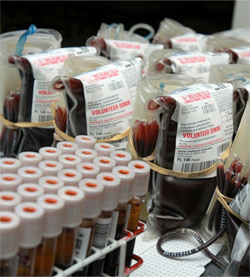 Every year in the U.S., nearly two-point-two million platelet units from donors are transfused to treat patients undergoing chemotherapy or surgery. But increasing demand, a short shelf life and risk of contamination keep platelets in tight supply. Now a new way to generate them could radically transform how we deal with the shortage.
Every year in the U.S., nearly two-point-two million platelet units from donors are transfused to treat patients undergoing chemotherapy or surgery. But increasing demand, a short shelf life and risk of contamination keep platelets in tight supply. Now a new way to generate them could radically transform how we deal with the shortage.
In the aftermath of a storm or other emergency, blood and platelet donations are always in demand.
Jonathan Thon, Ph.D., Associate Biochemist of Brigham & Womens Hospital in Boston, Massachusetts told Ivanhoe, Every major surgery or chemotherapy requires platelet transfusions and they cost the hospitals upwards of about two-billion dollars a year.
That has researchers like Thon looking for a solution.
We just dont have enough platelets to meet supply Thon explained.
Platelets are made in our bone marrow. Now, scientists are mimicking our physiology with a platelet bioreactor.
Thon said, Weve shown that we can make platelets that look, feel and essentially are real human platelets.
But better. Get this, platelets have a shelf-life of just five days, when you include screening for bacteria and transportation, it drops to two days. But with the bioreactor, Were effectively giving each one of our platelets a birthday, which means that every one of them should last for 10 days Thon told Ivanhoe.
Without the risk of disease transmission, Which will take an amazing amount of pressure off of the current blood supply system he said.
Thon says platelets could one day be made on demand and genetically engineered so theres no risk of patient rejection.
Thon said, Potentially this will be huge. It will revolutionize the way blood is managed and distributed not just in the United States, but around the world, saving lives with science.
Scientists are now working on the quality, function and safety of the platelets. Human trials are expected in 2018.